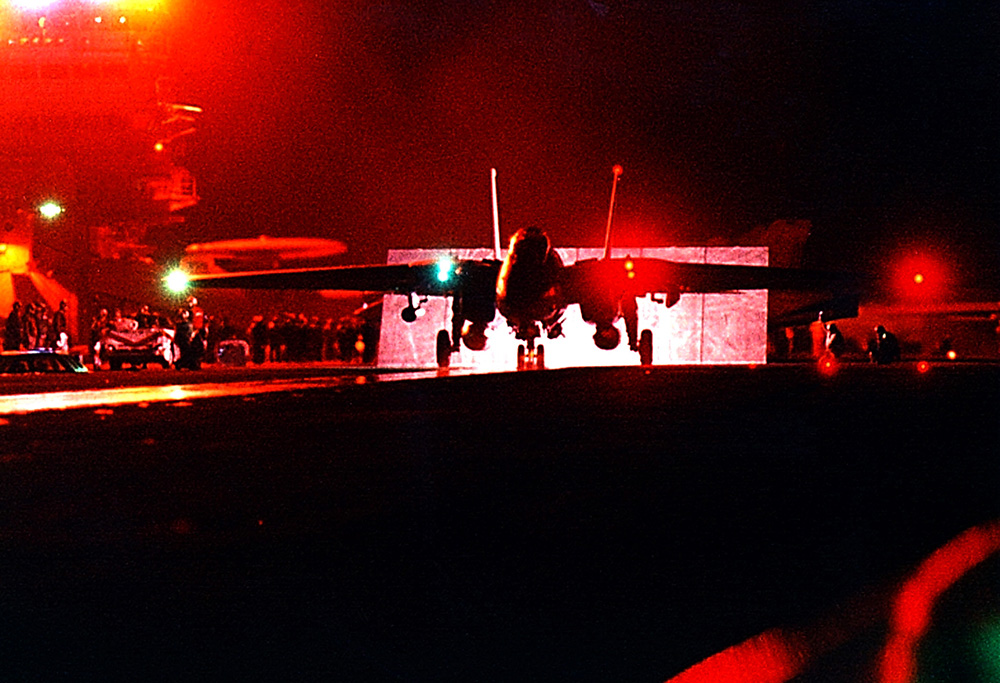Successfully accomplishing a night carrier landing takes a High Performing Team and a Culture of Excellence.
United States Naval Aviators and United States Marine Corps Aviators are the only pilots in the world who land high-performance fighters on aircraft carriers at night.
No one else in the world will even make the attempt.
There is no blacker emptiness than launching off the bow (the front end) of the carrier at night with no stars, no moon, and no horizon.
Except when you have to come back to the carrier and it’s time to land.

High-Performance and night carrier landings
It is a dark black hole, especially when the weather is bad. The best way to describe it is to walk into your closet with all the lights in your house off, at night, then blindfold yourself. And blindfold yourself again. Now try to do your job.
It’s one of the most incredible things you can experience, yet it’s also one of the most terrifying. Coming aboard the carrier at night makes even the most experienced, seasoned fighter pilot’s knees rattle like crazy and boots beat like a drum on the rudder pedals.
Unlike pilots in other military services or pilots of commercial aircraft, aircraft carrier pilots don’t have the luxury of landing on 6,000-10,000 feet. Because we are trying to land on a postage stamp in the middle of blackness.
A carrier landing is similar to a controlled crash. The touchdown is enough to destroy most other airplanes. As the arresting hook snags a wire, your body is slammed forward with such force at times it feels as though your legs and arms are going to separate from your body.
That’s what going from 155 knots to a complete stop in 1.2 seconds does to you.
You can do it well, but never perfectly. Every single pass is critiqued and Debriefed by the Landing Signal Officers (LSOs), and you’re graded no matter what your rank or experience level. A Culture of Learning, is a hallmark of carrier aviation. The ideas of learning before doing, learning during, and learning after guide all that we do. This allows us to understand what went right, what went wrong, and adjust as a team to a rapidly changing environment successfully.
Night Carrier Landing Equals High Performance
Extensive studies were performed on carrier aviators in Vietnam. Pilots were hooked up to EKG tests and their heart rates and breathing rates were measured. The test results were shocking: all of the carrier aviators had higher pulses and blood pressures behind the boat at night after a mission than they did when they were getting shot at.
You know why?
It’s dark, the deck pitches and heaves-sometimes up to 30 feet at a time and it requires every bit of skill, focus and attention a pilot can muster to get on board safely.
High-Performance Results Require Teamwork
We don’t do it all alone, however. It takes a High Performing Team supported by a Culture of Excellence oriented on winning to get the job done.
As you’ll see in the video below, attitude is everything. Taking what is a challenging situation, and harnessing that anxiety, even fear and turning it into something productive is key.
As a fearless leader, you set the tone for your team. A real winning attitude establishes standards of excellence, and maintains a positive outlook, even in turbulent times like below.
A positive, fearless, winning attitude doesn’t guarantee success, but a negative one almost always kills your ability to adapt.
Take a peek to see how it’s done:
On your journey to becoming the best you and the best leader you can be, the single most powerful piece of advice I can give to you is: Be fearless.
Take any anxiety and fear of failure and turn it into a sense of confidence—a spiritedness.
Follow whatever dream you have, and believe that it is enough. You will run into roadblocks, challenges, and naysayers. But you and you alone have the power to choose whether adversity will destroy you or make you better.
Choose wisely. Be Fearless…
 Carey Lohrenz is the author of the Wall Street Journal Best Seller “Fearless Leadership: High-Performance Lessons from the Flight Deck.”, a motivational speaker and leadership expert.
Carey Lohrenz is the author of the Wall Street Journal Best Seller “Fearless Leadership: High-Performance Lessons from the Flight Deck.”, a motivational speaker and leadership expert.
Carey has flown missions worldwide as a combat-mission-ready United States Navy F-14 Tomcat pilot. Her extensive experience operating in one of the world’s most challenging environments, an aircraft carrier, and her unique position as one of the first female combat pilots make her the perfect opening or closing inspirational keynote speaker for your corporate meeting or conference.
Carey graduated from the University of Wisconsin where she was a varsity rower, also training at the Pre-Olympic level. After graduation, she attended the Navy’s Aviation Officer Candidate School before starting flight training and her naval career. She is the mother of four kids, and is currently working on her Master’s in Business Administration in Strategic Leadership.







